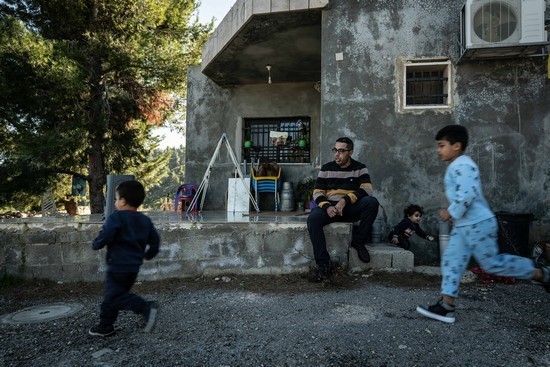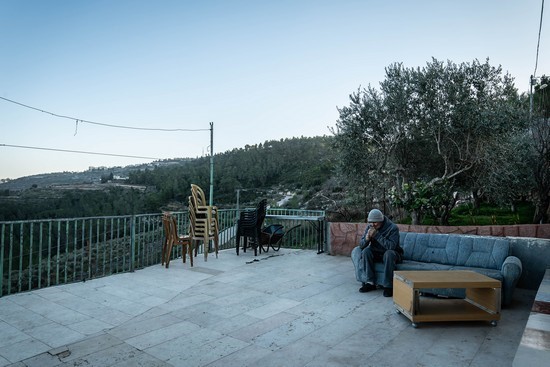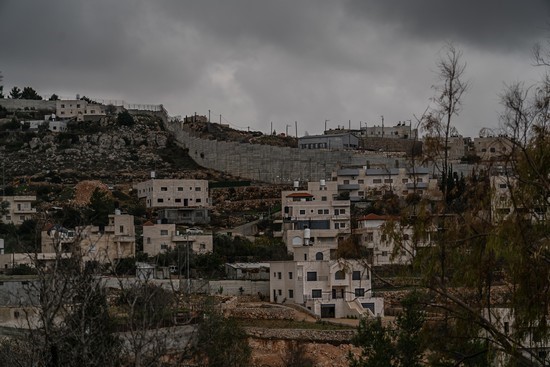On a gray metal gate that Israel built in the
Palestinian village
of Walaja hangs a biting sign: “Living behind this damned door and this
spiteful wall is your brother and your son Omar Essa Hajajlah.”
اضافة اعلان
The wall in
question is part of the 710km long barrier that Israel erected as a security
measure years ago, largely separating its territory from the occupied
West Bank. When it was built, it cut across Hajajlah’s long driveway, isolating him
from his neighbors. The gate allows him and his family to cross from their home
on one side of the wall into the rest of their village, though few are
permitted to freely cross in the other direction.
Many of the major
events that have shaped this corner of the
Middle East have left their mark on
Walaja — once a swath of terraced farmland with an ancient olive tree. Today,
it serves as a pointed example of how decades of occupation, war, diplomatic
agreements, Israeli settlement-building, laws, and regulations have carved up
the West Bank and whittled away at territory under Palestinian control.
The 3,000
Palestinian residents of Walaja now live partly in the occupied West Bank and
partly in
Jerusalem, divided into several different zones governed by different
laws and regulations. Palestinian leaders and rights groups say that this type
of fragmentation undermines the possibility of ever building a Palestinian
state on a contiguous piece of land.
 Ibrahim Araj with his children outside their unfinished home, which has been under a demolition order since 2016, in the West Bank village of Walaja, on January 8, 2022.
Ibrahim Araj with his children outside their unfinished home, which has been under a demolition order since 2016, in the West Bank village of Walaja, on January 8, 2022.
“They (Israel)
want a land without its people so they can take the land without war and
without loss of blood,” said Hajajlah, 57, sitting on a broken chair on his
terrace overlooking a valley with sheep grazing behind him. “And they are
succeeding in this.”
The shrinking
and division of Walaja began during the
1948 Arab-Israeli war when the 1,600
village residents fled their lands. This was part of what Palestinians call the
nakba, or the catastrophe, when hundreds of thousands were forced out of their
homes when Israel was created.
They resettled
on a neighboring mountaintop that was part of Walaja’s agricultural lands and
reestablished their village on territory held by neighboring Jordan.
In the 1967
Arab-Israeli war, Israel defeated several Arab states that were mobilizing
against it and seized control of the
Gaza Strip and the Sinai Peninsula from
Egypt; the West Bank and East Jerusalem from Jordan; and the Golan Heights from
Syria.
Walaja was part
of the captured West Bank.
Israel
subsequently drew new municipal boundaries for Jerusalem, annexing some 17,000
acres of the West Bank into the city — land still considered occupied territory
by most of the world and under international law. Jerusalem’s new municipal
boundary cut through Walaja, putting part of the village in the West Bank, governed
then by Israeli military law, and part in Jerusalem, where municipal laws and
regulations applied.
In the post-1967
era, some of Walaja’s lands were taken to build illegal Israeli settlements,
according to the
UN. Those settlements are a violation of international law,
though Israel insists that there has been a Jewish presence in the West Bank
for thousands of years.
 Omar Essa Hajajlah on the terrace of his home, which is separated from the rest of his West Bank village of Walaja by Israel’s wall, on January 10, 2022.
Omar Essa Hajajlah on the terrace of his home, which is separated from the rest of his West Bank village of Walaja by Israel’s wall, on January 10, 2022.
Then, in the
1990s, Israel and the Palestinians signed the Oslo Accords, the first peace
agreement ever between them, hailed at the time as a historic breakthrough.
Under the
accords, the West Bank side of Walaja was further divided into two zones — one
came under Palestinian administration, and the other remained under Israeli
control. Those designations have since determined what construction is
permitted and who permits it, among other rules.
The agreements
that created these divisions were meant to be temporary but took on a more
permanent air when the Oslo negotiations collapsed after failing to reach a
lasting settlement.
In 2002, after a
surge of
Palestinian attacks, Israel began building the separation barrier — a
system of fences and concrete walls running along or, in some places, inside
the West Bank. When construction of the wall reached Walaja in 2012, it added a
new division, isolating Hajajlah’s family from the rest of the village.
“Walaja is
representative of the fragmentation of Palestinian lands,” said Alon
Cohen-Lifshitz, an architect and urban planner with Bimkom, an independent
Israeli organization that campaigns for Palestinian land rights, which are
tightly restricted by Israel.
“The occupation
and the land grab is very sophisticated, and they are using all kinds of
techniques,” he added. “And planning is a very powerful tool.”
Israeli
officials have denied that they are trying to push
Palestinians off the land
and claim that, to the contrary in Jerusalem, the government has made it easier
for them to get building permits.

The wall built by Israel that divides the West Bank village of Walaja, on December 23, 2021.
“The security
fence was built to serve security needs and prevent terrorism,” the Israeli
Defense Ministry said in a statement.
Two signs
translated into English mark the entrance to Walaja: One in green reads,
“Al-Walajah Welcomes You.” The other, in red, says, “This Road Leads To
Palestinian Village The Entrance For Israeli Citizens Is Dangerous.”
In the section
of the West Bank side under full Israeli control, two- and three-story
structures dominate the landscape. But in the West Bank zone administered by
the Palestinian Authority rises a cluster of midlevel apartment buildings —
allowing for more Palestinians to move in.
And in the parts
of Walaja that are within the bounds of occupied Jerusalem, piles of rubble
line the winding mountain roads, a testament to Israeli laws on bulldozing
homes that lack building permits — a policy that overwhelmingly affects
Palestinians.
At least 32
homes have been demolished in Walaja since 2016, according to Ir Amim, a
Jerusalem advocacy group.
Ibrahim Araj and
37 other homeowners in Walaja have taken their fight against home demolitions
to Israel’s Supreme Court, a move that has forestalled the destruction. A
decision at the end of last month extended the injunction against demolitions
for these 38 homes for another seven months and gave the residents a chance to
advance a zoning plan that would allow them to apply for building permits.
The case only
protects those 38 homes, though.
“Walaja itself
is like a microcosm of all the violations that Israel commits,” said Araj, a
37-year-old lawyer, whose home has been under a demolition order since 2016.
From the front porch of his unfinished home, he can hear the sound of
construction from a nearby Israeli settlement on land that used to be part of
Walaja.
Hajajlah said he
felt like his family’s home, built over three generations, was an island unto
itself. Two cameras watch as he, his wife, and three sons come and go through a
gate in the separation barrier.
Israel’s Defense
Ministry said it worked to find a solution for the family and built a direct
passage to their home, allowing them to cross without restrictions. When inviting
guests, however, the family is required to notify the authorities, the ministry
said.
Before the wall
was erected, Hajajlah said his home hosted large gatherings, especially around
holidays. But his family and friends no longer want to come, concerned about
Israeli soldiers from a nearby checkpoint who patrol by his home regularly.
As he escorts
some rare guests out through the metal gate, he passes painted flowers and
pro-Palestinian graffiti on the separation barrier that reads: “Existence is
resistance.”
Read more Region and World
Jordan News




